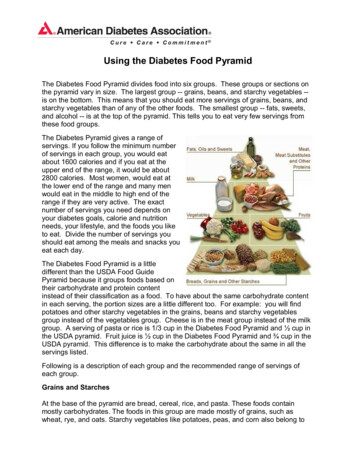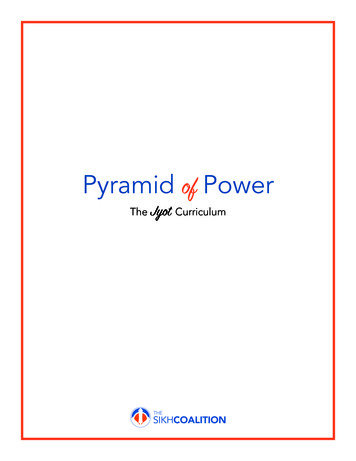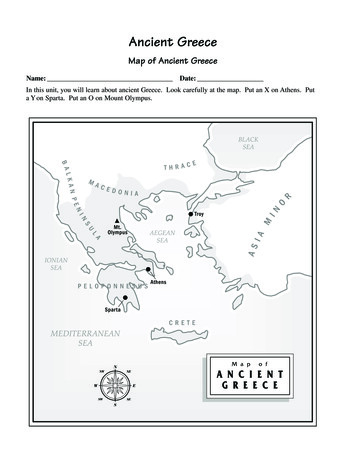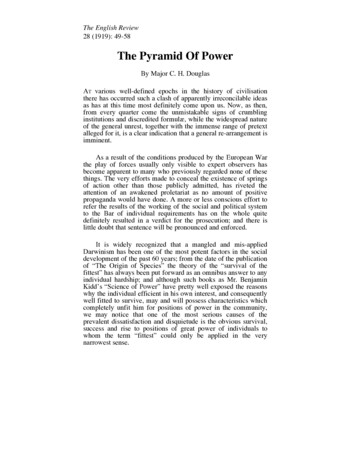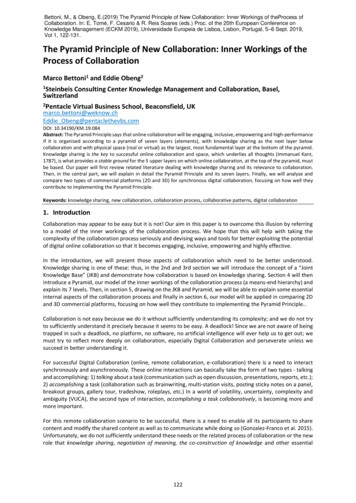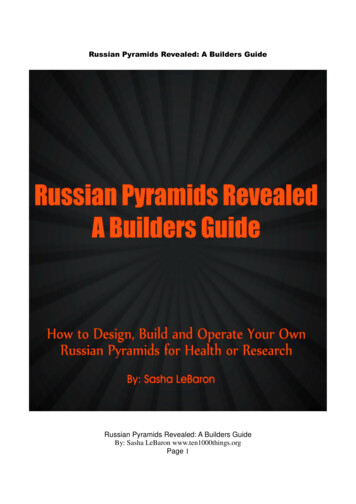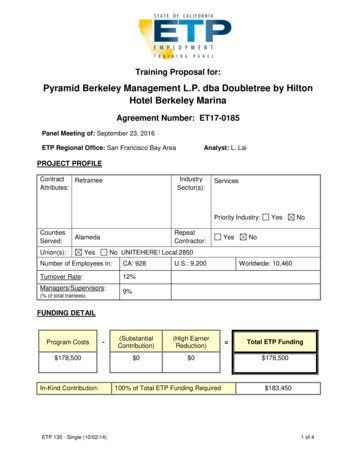
Transcription
F RO M T H EANCIENTWORLDThe Ancient EgyptianPyramid TextsJames P. AllenAllenJames P. Allen is Curator of Egyptian Art at The Metropolitan Museum of Artin New York and the author of The Art of Medicine in Ancient Egypt (MetropolitanMuseum of Art, Yale University Press), The Heqanakht Papyri (MetropolitanMuseum of Art), Middle Egyptian: An Introduction to the Language and Cultureof Hieroglyphs (Cambridge University Press), and other books on ancient Egypt.The Ancient Egyptian Pyramid TextsThe Pyramid Texts are the oldest body of extant literature from ancient Egypt.First carved on the walls of the burial chambers in the pyramids of kings andqueens of the Old Kingdom, they provide the earliest comprehensive view ofthe way in which the ancient Egyptians understood the structure of the universe,the role of the gods, and the fate of human beings after death. Their importancelies in their antiquity and in their endurance throughout the entire intellectualhistory of ancient Egypt. This volume contains the complete translation ofthe Pyramid Texts, including new texts recently discovered and published. Itincorporates full restorations and readings indicated by post-Old Kingdomcopies of the texts and is the first translation that presents the texts in the orderin which they were meant to be read in each of the original sources.WRITINGS
The Ancient Egyptian Pyramid Texts
Writings from the Ancient WorldTheodore J. Lewis, General EditorAssociate EditorsEdward BleibergBillie Jean CollinsF. W. Dobbs-AllsoppEdward L. GreensteinJo Ann HackettRonald J. LeprohonNiek VeldhuisRaymond WestbrookNumber 23The Ancient Egyptian Pyramid Textsby James P. AllenEdited by Peter Der Manuelian
THE ANCIENT EGYPTIANPYRAMID TEXTSTranslated with an Introduction and Notes byJames P. AllenEdited byPeter Der ManuelianSociety of Biblical LiteratureAtlanta
The Ancient Egyptian Pyramid TextsCopyright 2005Society of Biblical LiteratureAll rights reserved. No part of this work may be reproduced or transmitted in any form orby any means, electronic or mechanical, including photocopying and recording, or bymeans of any information storage or retrieval system, except as may be expressly permittedby the 1976 Copyright Act or in writing from the publisher. Requests for permissionshould be addressed in writing to the Rights and Permissions Office, Society of BiblicalLiterature, 825 Houston Mill Road, Atlanta, GA 30329 USA.Library of Congress Cataloging-in-Publication DataPyramid texts. English.The ancient Egyptian pyramid texts / [translated] by James P. Allen.p. cm. — (Writings from the ancient world / Society of Biblical Literature ;no. 23)Includes bibliographical references and index.ISBN-13: 978-1-58983-182-7 (paper binding : alk. paper)ISBN-10: 1-58983-182-9 (paper binding : alk. paper)1. Incantations, Egyptian—Translations into English. 2. Future life. I. Allen, JamesP., 1945– II. Title. III. Series: Writings from the ancient world ; no. 23.BL2430P9713 2005299'.3138—dc22200501657413 12 11 10 09 08 07 06 055 4 3 2 1Printed in the United States of America on acid-free, recycled paperconforming to ANSI/NISO Z39.48-1992 (R1997) and ISO 9706:1994standards for paper permanence.
CONTENTSSeries Editor’s Foreword . ixIntroduction . 1Spell Numbers . 3Editorial History . 4Genres of Pyramid Texts . 5The Function of the Pyramid Texts . 7The World of the Pyramid Texts . 8A Note on Translation .12I.The Pyramid Texts of Unis .15Spells for Protection of the Mummy .17The Offering Ritual .19Response to the Offering Ritual .29The Resurrection Ritual .31Spells for Emerging from the Duat .41Spells for Passing through the Akhet .43Spells for the Spirit’s Rebirth .50Spells for Leaving the Akhet .55Spells for Entering the Sky .60Notes .61II. The Pyramid Texts of Teti .65Spells for Entering the Womb of Nut .67The Offering Ritual .70The Insignia Ritual .71Response to the Offering Ritual .74The Resurrection Ritual .76Spells for Leaving the Duat .76
viCONTENTSSpells for Entering the Akhet .79Spells for Passing through the Akhet .84The Morning Ritual .85Spells for the Spirit’s Rebirth .88Spells for Leaving the Akhet .94Fragments .94Notes .94III. The Pyramid Texts of Pepi I .97Spells for Entering the Womb of Nut . 100The Offering Ritual . 110The Insignia Ritual . 113The Resurrection Ritual . 115Spells for Leaving the Duat . 118Spells for Proceeding to the Akhet . 121Spells for Entering the Akhet . 122Spells for Passing through the Akhet . 134The Morning Ritual . 141Spells for the Spirit’s Rebirth . 142Spells for Proceeding to the End of the Akhet . 147Spells for Passing from the Akhet to the Sky . 151Spells for Opening the Door of the Sky . 169Spells for Entering and Leaving the Tomb . 173Spells for Emerging into the Sky . 196Spells for Daily Life and Protection . 198Fragments . 200Notes . 201IV. The Pyramid Texts of Merenre . 209Spells for Entering the Womb of Nut . 211The Burial Chamber Rituals . 216Response to the Offering Ritual . 219Spells for Opening the Door to the Akhet . 220Spells for Entering and Proceeding through the Akhet . 221The Morning Ritual . 224Spells for the Spirit’s Rebirth . 225Spells for Proceeding to the End of the Akhet . 225Spells for Leaving the Akhet . 226Spells for Proceeding toward the Sky . 226Spells for Joining the Gods . 230Spells for Appearing at Dawn . 231
CONTENTSviiFragments . 235Notes . 236V. The Pyramid Texts of Pepi II . 239Spells for Entering the Womb of Nut . 241The Offering and Insignia Rituals . 251The Resurrection Ritual . 265Response to the Offering Ritual . 269The Morning Ritual . 271Spells for Leaving the Duat . 273Spells for Entering the Akhet . 278Spells for Crossing the Akhet . 282Spells for the Spirit’s Rebirth . 283Spells for Approaching the Sky . 289Spells for Leaving the Akhet . 297Spells for Proceeding toward the Sky . 297Spells for Joining the Gods . 299Spells for Appearing at Dawn . 299Fragments . 303Notes . 304VI. The Pyramid Texts of Queen Neith . 309Spells for Entering the Womb of Nut . 311The Offering and Insignia Rituals . 314The Resurrection Ritual . 321Spells for Passing through the Akhet . 327Spells for the Spirit’s Rebirth . 327Spells for Ascending to the Sky . 331Spells for Entering the Sky . 332Notes . 334Variants . 337The Pyramid Texts of Unis . 337The Pyramid Texts of Teti . 337The Pyramid Texts of Pepi I . 339The Pyramid Texts of Merenre . 346The Pyramid Texts of Pepi II . 353The Pyramid Texts of Queen Neith . 368Concordance of Text Numbers . 375A. Spells by Pyramid . 375
viiiCONTENTSB.C.D.E.F.Spells by Location . 396Spells by PT or Other Numbers . 399Spell Numbers and Spells not in Sethe’s Edition . 413Utterance Numbers of Faulkner’s Translation . 417MAFS Numbers . 418Bibliography . 419Glossary . 425Index . 445
SERIES EDITOR’S FOREWORDWritings from the Ancient World is designed to provide up-todate, readable English translations of writings recovered from theancient Near East.The series is intended to serve the interests of general readers, students,and educators who wish to explore the ancient Near Eastern roots ofWestern civilization or to compare these earliest written expressions ofhuman thought and activity with writings from other parts of the world.It should also be useful to scholars in the humanities or social sciences whoneed clear, reliable translations of ancient Near Eastern materials for comparative purposes. Specialists in particular areas of the ancient Near Eastwho need access to texts in the scripts and languages of other areas willalso find these translations helpful. Given the wide range of materials translated in the series, different volumes will appeal to different interests.However, these translations make available to all readers of English theworld’s earliest traditions as well as valuable sources of information ondaily life, history, religion, and the like in the preclassical world.The translators of the various volumes in this series are specialists inthe particular languages and have based their work on the original sourcesand the most recent research. In their translations they attempt to conveyas much as possible of the original texts in fluent, current English. In theintroductions, notes, glossaries, maps, and chronological tables, they aimto provide the essential information for an appreciation of these ancientdocuments.The ancient Near East reached from Egypt to Iran and, for the purposes of our volumes, ranged in time from the invention of writing (by3000 B.C.E.) to the conquests of Alexander the Great (ca. 330 B.C.E.) .
xIntroductionThe cultures represented within these limits include especially Egyptian,Sumerian, Babylonian, Assyrian, Hittite, Ugaritic, Aramean, Phoenician,and Israelite. It is hoped that Writings from the Ancient World will eventually produce translations from most of the many different genres attestedin these cultures: letters (official and private), myths, diplomatic documents,hymns, law collections, monumental inscriptions, tales, and administrativerecords, to mention but a few.Significant funding was made available by the Society of BiblicalLiterature for the preparation of this volume. In addition, those involvedin preparing this volume have received financial and clerical assistancefrom their respective institutions. Were it not for these expressions of confidence in our work, the arduous tasks of preparation, translation, editing,and publication could not have been accomplished or even undertaken. Itis the hope of all who have worked with the Writings from the AncientWorld series that our translations will open up new horizons and deepenthe humanity of all who read these volumes.Theodore J. LewisThe Johns Hopkins University
INTRODUCTIONAT THE END OF THE OLD KINGDOM, the walls of the inner chambers andcorridors of ancient Egyptian pyramids were inscribed with a series of ritualand magical spells, known to modern scholarship as the Pyramid Texts.These inscriptions constitute the oldest body of Egyptian religious writings;usually literary in form and language, they are also the oldest representativesof Egyptian literature. In both respects, the Pyramid Texts are primarysources for the history of ancient Egyptian thought and its relationship tothat of the biblical world.To date, Pyramid Texts have been found in the tombs of ten kings andqueens at Saqqara, the necropolis of the Old Kingdom capital, Memphis:Unis (Dynasty V, ca. 2353–2323 B.C.)Teti (Dynasty VI, ca. 2323–2291 B.C.)Pepi I (Dynasty VI, ca. 2289–2255 B.C.)Ankhesenpepi II, wife of Pepi IMerenre (Dynasty VI, ca. 2255–2246 B.C.)Pepi II (Dynasty VI, ca. 2246–2152 B.C.)Neith, wife of Pepi IIIput II, wife of Pepi IIWedjebetni, wife of Pepi IIIbi (Dynasty VIII, ca. 2109–2107 B.C.).After the end of the Old Kingdom, if not earlier, copies of Pyramid Textswere also inscribed on tombs, sarcophagi, coffins, canopic chests, papyri,stelae, and other funerary monuments of nonroyal Egyptians, along withnew or revised texts known as the Coffin Texts.1 In the New Kingdom andlater, some Pyramid Texts were incorporated into newer funerary compositions such as the Mouth-Opening Ritual and the Book of the Dead, andthe texts continued to be used until the end of pharaonic civilization.
2THE ANCIENT EGYPTIAN PYRAMID TEXTSThe Pyramid Texts were first discovered in 1880 and have been thesubject of ongoing study and excavation ever since, with new finds asrecently as 2001 (the texts of Ankhesenpepi II). Most of the texts of Unis,Teti, Pepi I, Merenre, and Pepi II were first published by their discoverer,Gaston Maspero. A concordance of these five corpora, prepared by KurtSethe, appeared in 1908 and is still considered the standard edition of thePyramid Texts. At that time, only Unis’s texts were known in their entirety;the subterranean chambers of the other four kings’ pyramids had yet to becompletely cleared of debris, and many of their inscribed walls existedlargely as fragments in unexcavated rubble. In the first half of the lastcentury, French expeditions led by Gustave Jéquier cleared Pepi II’schambers, excavated four newly discovered pyramids with Pyramid Texts(those of the king’s wives Neith, Iput II, and Wedjebetni, and that of thepharaoh Ibi), and eventually published the complete corpus of texts fromeach of these five pyramids. Since 1958, expeditions under the direction ofJean-Philippe Lauer, Jean Sainte Fare Garnot, and Jean Leclant have workedat clearing and restoring the remaining Old Kingdom pyramids of Teti,Pepi I, and Merenre. The complete publication of Pepi I’s Pyramid Textsappeared in 2001; those of the other two pyramids and the newlydiscovered texts of Ankhesenpepi II are currently in preparation.An English translation of the Pyramid Texts was published by SamuelB. Mercer in 1952, based on Sethe’s edition; another of Unis’s texts aloneby Alexandre Piankoff in 1968; and a third by Raymond O. Faulkner in1969, incorporating the texts of Pepi I and Neith published by Jéquier.Though useful in many respects, each of these has its disadvantages. Sincethe appearance of Faulkner’s translation, Egyptology has made considerableadvances in understanding both the language and the religious background of the texts, in some cases leading to significantly differentinterpretations, and the recent publication of Pepi I’s complete corpus hasadded substantially to the genre. Though many of the Pyramid Texts arerepeated in each pyramid, research has also shown that each corpus wasconceived as a unit, with the texts meant to be read from wall to wall in aspecific order. Of the three English translations, only Piankoff ’s reflects thisfeature, though it has misunderstood the sequence. The other two presentthe texts in the artificial order of their publication in Sethe’s edition, whichconceals both the sequentiality of each corpus and the relationship between the texts and the walls on which they were inscribed.The present work is intended to rectify these shortcomings, insofar aspossible. It includes translations of the Pyramid Texts found in the pyramidsof Unis, Teti, Pepi I, Merenre, Pepi II, and Neith, each corpus in the order inwhich current research indicates it was most likely meant to be read. Four
INTRODUCTION3of these sources have been completely published and are presented here intheir entirety; those of Teti and Merenre, still awaiting full publication, arepresented here as completely as the current state of publication allows.Considerations of space have made it necessary to omit the texts ofIput II, Wedjebetni, and Ibi. Those of the two queens, however, are represented by a collection of fragments and add almost nothing new to thecorpus, and the texts of Ibi, though better preserved, stand somewhat apartfrom the main Old Kingdom tradition represented by the Pyramid Texts ofhis predecessors. To keep the volume to a reasonable size, the texts found inmore than one pyramid have usually been limited to a single translation. Insuch cases the earliest and most completely preserved copy has generallybeen translated. Subsequent instances of the same text are referenced to thisprimary translation; those marked by an asterisk (*) have one or more majortextual variants, which are recorded in an appendix.2 In a few instances thenumber or character of the variants has been deemed substantial enough towarrant a separate translation. These exigencies aside, I hope that this newtranslation will make it possible for the interested reader to appreciate betternot only the content of the texts but also the spatial and sequential relationships intended by their creators.SPELL NUMBERSThe Pyramid Texts of the Old Kingdom are inscribed mostly in verticalcolumns on the interior walls of each pyramid.3 They are divided into spells:units of varying length, from a few words to several hundred, each usuallypreceded by a monogram for the direction ÿd-mdw “Recitation” andmarked at the end by a sign taken from the hieroglyph for œwt “chapter”or “section” (literally, “enclosure”).The sporadic history of the discovery and publication of the PyramidTexts has had an unfortunate side-effect in the conventions used to referto these spells. Sethe numbered the spells known at the time of his publication sequentially, beginning with Unis’s texts and appending those of Teti,Pepi I, Merenre, and Pepi II, mostly in chronological order.4 He also subdivided each spell into phrases, again numbered sequentially in the same orderfor the entire corpus. The individual spells of Sethe’s edition are thus citedby two sets of numbers, referring to spells (PT 1–714) and phrases (Pyr. or§§ 1a to 2217b): for instance, PT 511, subdivided into Pyr. 1149a–1161c.5 Ina few cases these spell numbers reflect the order in which the spells weremeant to be read: for example, PT 108–171, which are sequential in eachcorpus. In almost no instance, however, do they indicate the true positionof the spell in the sequence of an individual pyramid: thus, the first spell inUnis’s corpus is Sethe’s PT 226.
4THE ANCIENT EGYPTIAN PYRAMID TEXTSJéquier’s publication of the texts of Pepi II and Neith added considerably more material to the corpus of Pyramid Texts. In some cases thenew texts revealed that a fragmentary sequence from one pyramid towhich Sethe had assigned a single spell number actually consisted of several spells, from two (e.g., PT 658) to as many as seventeen (PT 502). Topreserve Sethe’s numbering system, the new divisions were assigned supplemental letters (e.g., PT 658A–B)—though not, unfortunately, uniformlyby all scholars.6 Others of the new texts did not correspond to any of thespells numbered by Sethe; a few of these were discovered to be copies ofspells previously known only from the later Coffin Texts.7 Subsequent research and the new publication of Pepi I’s complete corpus has revealedthe need for yet further modification of Sethe’s numbering system.The complexity and inconsistency of the current system of PT numbers often makes it difficult to know how to refer to a particular spell orto which spell a particular number refers—a state of affairs that will persistuntil all the pyramids have been completely published and a new editionof the full corpus of Pyramid Texts has been prepared. Because of thesedifficulties, I have avoided the use of PT numbers in the translations(though not in the notes). To make it possible to refer to individual spells,those of each pyramid are numbered consecutively in the order of theirappearance; a concordance of these numbers with those of Sethe’s system(revised) is presented in the Appendix.8EDITORIAL HISTORYAlthough they are first attested in the pyramid of Unis, most of thePyramid Texts are undoubtedly older. With few exceptions, their grammaris that of a stage of the language that disappeared from secular inscriptionsat least fifty years earlier, and the architecture of the pyramid chambersthat they reflect (see below) came into use at the end of the FourthDynasty, more than a hundred years before Unis’s time. Some of the textsalso reflect burial practices that are even older, in earthen graves beneathtombs built of mudbrick. Newer spells that first appear in the laterpyramids, however, incorporate features of the contemporary language.Overall, the Pyramid Texts give the impression of a corpus that hadbeen in use for some time before it was inscribed in Unis’s pyramid and onethat was continually revised and amplified during the reigns of his successors. The process went on after the end of the Sixth Dynasty, in the EighthDynasty corpus of Ibi and that prepared for the burial of the Ninth-Dynastyking Wahkare Khety (ca. 2030 B.C.).9 The Coffin Texts of the Middle Kingdom incorporate copies and revisions of some Pyramid Texts, and are mostlya continuation of the older tradition rather than a distinct corpus.
INTRODUCTION5Although the Pyramid Texts of the Old Kingdom were inscribed onlyin royal tombs, the texts themselves give evidence of a less exclusive use.Many of them were originally in the first person, meant to be spoken bythe deceased’s spirit and thus not restricted to a particular individual.Those addressed to the deceased by name occasionally preserve indicationsof a generic original, with directions to the celebrant indicating where thedeceased’s name was to be inserted.10 A few spells from the kings’ pyramidsalso seem to make reference to the deceased as someone other than theking himself.11Occasional mistakes in the use of some hieroglyphic signs indicate thatthe master from which the texts were transcribed to the pyramid walls was apapyrus scroll written in a semi-cursive script—in line with the commentsof the preceding paragraph, probably a manuscript that was not specific toany one individual. The inscriptions in the pyramids of Unis and Pepi I,which have been studied in detail, show traces of editorial revision after thetexts were first carved—in the case of Pepi I, even amounting to revision ofentire sections of a wall.Most of the editorial revisions have to do with the replacement of anoriginal first-person pronoun by the deceased’s name or a third-person referent, thus “personalizing” the texts for each pyramid. In some cases thesechanges took place after the original version was carved and are visible onthe wall; in others, the original first person can be deduced from pronounsoverlooked by the editor, from grammatical constructions left unemended,or from variant uses of the deceased’s name and a third-person pronoun indifferent copies.12 In translating such spells, an argument can be made bothfor adopting the original first person and for rendering the final thirdperson version. The separate treatment of each of the six corpora in the present translation has made it possible to use the latter approach, which reflectsmore closely the sense of the texts as it was intended in each tomb.13GENRES OF PYRAMID TEXTSThe spells of the Pyramid Texts that address the deceased in thesecond person are ritual in nature. Originally recited by a lector priest inthe role of the deceased’s son during rites that probably took place at thefuneral, they were carved on the walls of the pyramid’s chambers to ensuretheir ongoing effectiveness. The Pyramid Texts contain three major groupsof such spells: the Offering and Insignia Rituals, the Resurrection Ritual,and the Morning Ritual.The Offering and Insignia Rituals always appear on the north wall ofthe burial chamber. Perhaps originally distinct, they are generally combinedinto a single ritual in the pyramids. The Offering Ritual accompanied prep-
6THE ANCIENT EGYPTIAN PYRAMID TEXTSarations for and the presentation of a great meal, beginning with a libation,cleansing with incense and salt-water, and the “Opening of the Mouth,” inwhich the deceased’s ability to partake of nourishment was ritually restored.In the Insignia Ritual, items of royal dress and regalia were offered to astatue of the deceased, which was then presented to the gods in procession.The two rituals generally end with a formal “Reversion of Offerings” to thedeceased and the smashing of the ritual vessels.Both rituals consist mostly of short spells recited during the presentation of an offering and generally accompanied by a direction indicating theobject presented. The spells often incorporate a word-play with the name ofthe offering, which cannot always be rendered in translation: for example,“Osiris Unis, accept Horus’s eye, which you should embrace” (PT 128,Unis’s Spell 90), where the qualification zãnt.k “which you should embrace”reflects the presentation of zãnw “kidneys.” The offering is usually called“Hor
Mar 07, 1983 · corridors of ancient Egyptian pyramids were inscribed with a series of ritual and magical spells, known to modern scholarship as the Pyramid Texts. These inscriptions constitute the oldest body of Egyptian religious writings; usually literary in form and language, they are also the oldest
